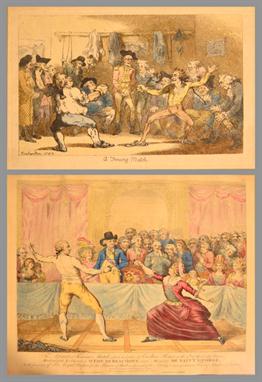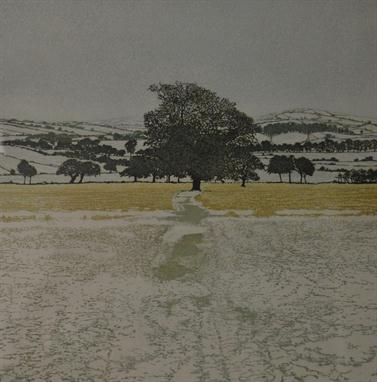We found 314753 price guide item(s) matching your search
There are 314753 lots that match your search criteria. Subscribe now to get instant access to the full price guide service.
Click here to subscribe- List
- Grid
-
314753 item(s)/page
After M. BROWN; an 18th century black and white engraving depicting Monsieur de St. George, engraved by William Ward, 38 x 30cm, an 18th century hand coloured print published by The Art Direct, September 1st 1798 by H. Angelo Curzon, 28.5 x 34cm, and a further 19th century print depicting soldiers practicing sword fighting, 20.5 x 31cm, all framed and glazed.
A 19th century coloured print depicting the fencing match which took place at Carlton House, 9th April 1787, titled, published by Combeau, Paris and by Robinde, London, 32 x 34cm, and after ROWLANDSON; a comical coloured fencing print "A Fencing Match", 18 x 27cm, both framed and glazed (2).
A mixed lot comprising a modern oil on board, Dutch river scene with figures and windmills beyond, unsigned, 12.5 x 17cm, framed, SINKS; watercolour depicting a two masted vessel "Whitby", signed lower right and titled lower left, 31 x 18.5cm, a further watercolour depicting a rural scene and a print, also a watercolour drawing of a cartoon young girl (5).
Hornby and Lima 00 Gauge SR and LNER Coaches and Railway Books: Hornby SR (7), BR SR (1), LNER teak style (10, including three Tri-ang Scotsman coaches), Lima BR SR (4, roofs repainted), Wrenn green Utility van (roof painted ) and Hornby 4-wheel Track cleaning coach, G-VG , some coaches with minor modifications, together with books (3) and small railway print, G (28)
Merioneth. Speed (John), Merionethshire Described, sold at the Corner of Hemmings Row in St. Martins Lane, n.d., c.1680, hand coloured engraved map, inset map of Harlech, strapwork cartouche and mileage scale, very slight toning, 385 x 505mm, no text on verso. The published imprint is a separately printed piece of paper pasted over a ‘Bassett & Chiswell’ imprint. Hemmings Row was home to a large number of book binders, book, map and print sellers and stationers including M.Hennekin, C.Meyer, D.Battiscombe and C.Fowler. The address appears on several 18th century mezzotint portraits including a fine portrait of Christopher Wren by G.Kneller sold by M.Hennikin. However we can find no record of this imprint on a John Speed map. (1)
* Gould (John and Richter, H.C.). A collection of eight prints originally published in ‘The Birds of Great Britain’ [1862 - 73], lithographs with bright contemp. hand colouring, one print with ‘punch holes’ to upper margin not affecting image, each approx. 360 x 480mm. The prints consist of :- Podiceps Nigricollis, Podiceps Minor, Glareola Pratincola, Falcinellus Igneus, Otis Tetrax, Crex Pratensis, Cinclus Melanogaster and Porzana Minuta. (8)
* Stubbs (George, 1724-1806). Tygers at Play, pub. George Stubbs, 1780 [but later impression, pub. 1974 by Thomas Ross & Son], uncoloured line and stipple etching, 380 x 480mm. Christopher Lennox-Boyd, Rob Dixon & Tim Clayton. George Stubbs, The Complete Engraved Works, no. 60. State IIIa. The notes field for this item describes how this plate was purchased by Edward Orme in 1817 and then disappeared, only to emerge on the premises of London print makers Thomas Ross & Son in 1970. They published a small limited edition in 1974 and the plate is now held by the Trustees of the Tate Gallery. (1)
Tolkien (J.R.R.). The Hobbit, Or There and Back Again, 1st ed., 1937, b & w illustrations by the author, single leaf advert. leaf at end, map endpapers, publisher’s ‘File Copy’ ink stamps to front map endpaper and front free endpaper, top edge stained green, original green cloth with blue wraparound illustration of Smaug and mountains, spine a trifle rubbed, 8vo. J.R.R. Tolkien’s award-winning fantasy novel was published on 21 September 1937, 1500 copies were printed and sold out by 15 December. Originally conceived in the late 1920’s-early 1930’s to entertain his three sons, Tolkien recalled in a letter to W.H. Auden in 1955: ‘All I can remember about the start of The Hobbit is sitting correcting School Certificate papers in the everlasting weariness of that annual task forced on impecunious academics with children. On a blank leaf I scrawled: “In a hole in the ground there lived a hobbit.” I did not and do not know why. I did nothing about it, for a long time, and for some years I got no further than the production of Thror’s Map. But it became The Hobbit in the early 1930’s...’. The book has gone on to sell an estimated 100 million copies worldwide since first publication and has never been out of print. Hammond A3. Believing that the best judge of children’s literature were children themselves it was the habit of Sir Stanley to pay the young Rayner a shilling (five pence) for each reader’s report. Teh ten-year-old Rayner was given the manuscript of The Hobbit by his father in 1936 and for which he wrote this positive report, the original of which is held at the University of Reading: “Bilbo Baggins was a hobbit who lied in a hobbit-hole and never went for adventures, at last Gandalf the wizard and his dwarves perswaded him to go. He had a very exciting time fighting goblins and wrags, at alst they got to the lonley mountain; Smaug, the dragon who gareds it is killed and after a terrific battle with the goblins he returned home - rich! This book, with the help of maps, does not need any illustrations it is good and should appeal to all children between the ages of 5 and 9.” Sir Stanley duly went ahead and published the book in autumn of 1937. In honour of his services to Tolkien publishing the Tolkien Society presented Rayner with a 1936 King George V one shilling piece at the Tolkien centenary celebrations Oxford in 1992. The shilling is offered here with this lot. It is suspended in perspex set in a small wooden desk frame (13 x 15 x 6 cm) with a gilt plaque from the Tolkien Society front and back. Sadly, this is not the original shilling, Rayner admitting on receipt of this gift that the original had long since been spent on sweets. (2)
Tolkien (J.R.R.). The Lord of the Rings: The Fellowship of the Ring, 1954; The Two Towers, 1954; The Return of the King, 1955, 1st eds., 1st impressions, folding map at end of each, top edges stained red, original red cloth (one or two light stains), d.j.s, Fellowship spine toned, slipcase, 8vo. Each volume signed by the author to front endpaper. Hammond A5. Wayne Hammond’s Tolkien bibliography initially stated that the first state of Return of the King had signature ‘4’ and all line of type ‘sag’ in the middle on page 49. He now agrees that the first state contains no signature and straight lines of text, as per the present copy. A copy of the eight-page pamphlet ‘The Making of The Lord of the Rings’ by Rayner Unwin (Oxford: William A. Meeuws), 1992 (Copy B) is presented with this lot. This personal account of the agonies for author and publisher in bringing Tolkien’s revered masterpiece into print is an astonishing story of an author-publisher relationship in the traditional sense. So easily the book may never have been published were it not for Rayner’s belief in Tolkien’s self-confessed ‘monster’. When the project eventually moved forward into costings Rayner wrote to his father, then travelling on business in Japan, that based on dividing the book into three it would still lose money. ‘His reply was a model of what is now called hands-off management. If, he wrote, you beleive it is a work of genius, then you may lose a thousand pounds.’ Even then it was nearly two years of headaches before the first volume ran off the press. Tolkien was uncomfortable with the ambiguities of The Two Towers as a title to the second part and it was Rayner who chose the title of the third and final part, winning over Tolkien who preferred The War of the Ring, so as not give away so much of the plot! Then there was the difficulty of the maps, the printers and their proof-reading corrections for Tolkien’s deliberate quirky spelling, plus the appendices, the dust jacket designs and so forth. ‘And so the tortuous saga drew to a close. A last six-page letter of minute queries in the final proofs, a response with additional queries from the printer which reached Tolkien in Assisi (a rapid excursion from Gondor as he called it), and then silence while the book was being printed. Publication was fixed for 20th October 1955 and with it The Lord of the Rings was completed. It seemd an awful anti-climax. I had gone abroad, so Tolkien wrote to my cousin Philip and said Hurray. The rest is history.’ (3)
Hans Feibusch, Kneeling Male Nude, coloured limited edition print, No3/10, signed in pencil and dated 1939, 34 x 53cm, together with a coloured print of a guitarist by Waser, signed in pencil, 31 x 56cm, both in stained wood frames, and a painting by Ward, Nymph holding a flower, signed, 38 x 55cm
-
314753 item(s)/page













































